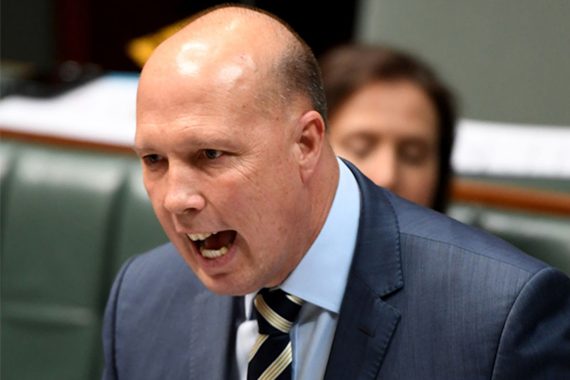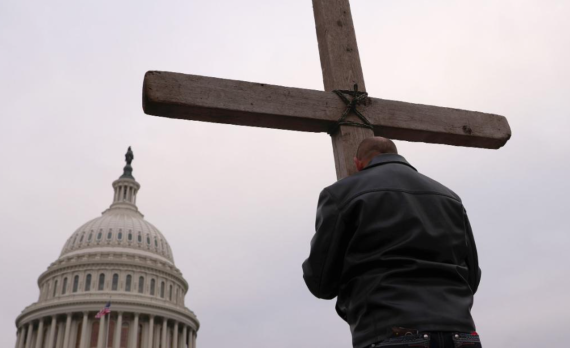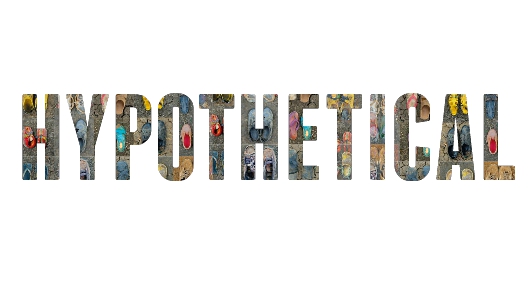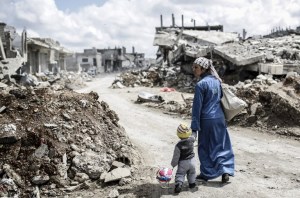Australians have begun to see the new face of extreme religion in our “conservative” politics. The international influences are varied and interconnected. These radical forces are not a private feature in politicians’ lives, but threaten the freedoms we value. It is only through better understanding the global impacts that we can protect our democracy.
There was jubilation around Australia at the defeat of the Morrison government in May. Some rejoiced at ousting the man himself. For others the relief was inspired by the majority uniting against a government signifying climate inaction or corruption or misogyny. Scott Morrison’s insertion of American-style religion into the Australian civic space contributed to his loss. If Australians had understood how alien this ideology is, it would have been much more central. The defeat of Morrison, however, is not the end of that religious intrusion into Australian “conservative” politics; it is part of the global phenomenon of reactionary Religious Right authoritarianism. In the month Morrison left the Lodge, the American majority was reeling at the implications of the leaked Supreme Court decision on Roe v Wade. In Europe, Queer Ukrainians were finding themselves pincered between the deep sexual stigma that pervades the culture of the invading Russians as well as the countries like Poland and Hungary where many are finding refuge. The Australian Religious Right draws on the power of the global movement’s successes like the Dobbs decision. It becomes more dangerous in its merging with secular bigotries and reactionary forces. Reflecting global political trends, it works not for “the next election, but the next generation.” It, and the culture wars that harness its votes, will not be backbenched with Morrison.
It is not only the faith-driven that make Religious Right politics a threat. These forces are bolstered by marriages of convenience between apparently incompatible forces. Secular libertarian members of the Republican Party embrace social conservatism and even perform devotion to faith to draw in the energised Religious Right voting bloc. British Tories are a dominant model for the Australian secular Right politicians with their boisterous “war on woke” which carries out overlapping attacks without the religious foundation. LGBTQI people and reproductive rights are the crucial targets for the interlinked movements. Trans people’s existence provides the wedge towards driving all LGBTQI people back into the closet. Britain has fallen from first to 14th place in LGBTQI rights rankings in only seven years, concurrent with the Tories’s Brexit debacle. Attacks on feminism from the traditional sex-role obsession of the Religious Right and defensive traditionalism of the secular Right are underpinning attacks on access to abortion. Driving women back out of the civic space and into the home is a shared passion. These campaigns are expanded in daily retail politics through disingenuous Right Wing media outlets in their culture war battles against the Left.
For less faith-driven “conservative” politicians, religion can also be deployed as a core characteristic of an embattled – mythical – national culture. Throughout the West this manifests as denoting Christianity as an integral component of Western Civilisation, also coded as White.(1) Any attention granted to First Nations or non-White people within the Right’s self-defined White nations is defined as divisive rather than reparatory. Reversing the various gains of the civil rights era is the goal. The blending of misogyny and various bigotries into the “conservative” supporter base draws misogynist Men’s Rights activists and White Supremacists into the cohort. There is a strong thread of this in Australian “conservative” politics with Tony Abbott (alongside his Budapest posse) as the most obvious warrior in defence of “Western Civilisation.” In Australia, we recently saw Bob Katter and Pauline Hanson touting their sudden interest in our Christian roots, with Katter even emulating Trump holding a bible aloft. This was posed as a rebuttal to Labor discussing a First Nations Voice to Parliament as well as the question of the relevance of Christian prayer in a secular Parliament. Inclusion is depicted as a destruction of all the glories of tradition. Diversity is an existential threat.
Pentecostal implacability
Given that the Australian “conservatism” has modelled itself particularly on its American partners for decades now, the US provides us with a critical warning. In America, the electoral contest is no longer a tussle between competing political platforms and styles; Religious Right dominance of the “conservative” party has made democracy literally impossible. Ezra Klein has analysed the current polarisation of their politics and noted that the overlap of many aspects of social identity has made political ideology far more tribal than it was historically. More problematic than that, however, is the certainty in Religious Right politics that the Left is an existential threat with no right to form government. While conservative Catholics and other faiths buttress the causes of the Religious Right in America, its dicta are dominated by Evangelical/Pentecostal tenets.(2) In this version of Christianity, Dominionism is central. This is the idea that Evangelical versions of Christianity must dominate the Seven Mountains of the civic space including government. The purity of the nation must be legislated and enforced. Within this cosmology, a secular state is a Satanic obstacle. Perhaps worse is the fact that natural disasters are seen as harbingers of End Times, so the more dramatic the impacts of the climate emergency, the more rapidly purified the nation must be.
The degree to which the growing Pentecostal movement is a poor fit with democracy requires understanding. Most institutions preach “spiritual warfare” where “literal demons” are present in people and events. Trump’s neo-charismatic “personal pastor,” Paula White, preached that Trump was fighting “a worldwide demonic conspiracy.” In this fringe world, LGBTQI people smell of demons and African and Asian sorcerers are a threat. Catholics and Mormons are said to practise dark magic. They argue that places and institutions such as bureaucracies, universities and journalism itself can be taken over by demonic forces. Spiritual warriors saw the Republican red of the map illustrating Trump’s victory as showing the “blood of Jesus” cleansing America’s sins. His election signified the looming overthrow of “Jezebel,” the literal demonic spirit behind reproductive and LGBTQI rights. The fantastical ideas that are compulsory parts of faith in these churches ready its adherents to accept other fantasies. In the pandemic era, the rapid growth of QAnon pervaded the evangelical churches, evident in Pentecostal Scott Morrison’s apology for “ritual” child abuse in Australia. QAnon’s focus on evil progressive elites stealing children was a comfortable fit for a faith that sees progressive political parties as evil. Much of the Trump support has taken on a religious devotional tone where he is the new saviour from the demonic Left.
Most Pentecostal/Evangelical traditions furthermore believe in a Rapture or Millennial Kingdom which destroys any impetus to tackle the climate crisis. Looming “End Times” create enormous anxiety about current moral status, but not about the future of the planet. This majority believes that storms and plagues are further signs of the imminence of the desired Premillennial moment. Geopolitical tensions arising from climate pressures will only be interpreted as more apocalyptic signs. Global action involves working with global political entities. Global entities, however, are depicted as aligned with the Antichrist. This is compounded by strategists within the fossil fuel sector driving Evangelicals to embrace these mineral resources as God’s gift which it would be ungrateful to leave in the ground. Rational debate is scotched in the face of divine mandate.
In this worldview, progressives are “godless.” Secularism is still linked to Communism. The freedom they demand is not “freedom from” but “freedom to.” The freedom to “force others to be free” only possible by “obedience to one narrow understanding of God’s plan.” Secular freedom, by contrast, leads to “chaos” and authoritarianism because tolerance is an imposition. The Evangelical movement’s pressure on American politics is such that no movement to protect equal rights is safe. The purity mission drives illogical policy making as well as being harmful to individuals within the churches. The attack on LGBTQI rights is such that the Southern Poverty Law Center has labelled a number of these lobby groups and churches as hate groups. The Dobbs decision overturning Roe v Wade and the resultant extremity of several states’ abortion laws illustrates the degree to which reproductive-aged women and AFAB people will be constrained and surveilled. Removing access to contraceptives has been raised too. The implication is that women’s access to the civic space will be revoked by uncontrolled fertility, and LGBTQI existence will be erased either visibly or actually.
This is not a movement that thinks in election cycles. It has taken almost a century for American businessmen and preachers appalled by atheist communism to make over the Republican Party as a Christian Libertarian force. Civic programs and civil rights were seen as the work of the enemy, crushing liberty. The government had no place in replacing elective charity with state programs. Instead of the sexual tolerance of libertarianism, however, this ideology is controlling. Socially, reactionary White Christians wanted their wives obedient, Segregation in place and their youth docile and chaste. Racism was inherent in White Evangelical churches, and a toxic emphasis on women’s purity and submission accompanied this. Jerry Falwell’s Moral Majority took the decision to unify the movement over the issue of abortion and it became a powerful force against political liberalism through the 1980s. Together with Billy Graham they brought Christian Libertarianism and the Evangelical bloc ever closer to the levers of power.
Pentecostal/Evangelicals are now central to Republican power. Donald Trump received 80% of the white Evangelical vote in 2016 and 75% in 2020. They form 35% of the Republican coalition. Trump’s personal sins are dismissed in the pursuit of the rewards he could grant for their loyalty. In 2022 his demographic offers even more fervent support for his Big Lie with the convergence between Evangelicals and Qanon followers. The labels Christian Nationalist and even Christian Fascist are being embraced by the MAGA Right now. Trump surrounded himself with Evangelical and conservative Catholic figures. He achieved the primary goal of this coalition when he handed them control of the Supreme Court, one of America’s primary law-making institutions. The Federalist Society which gave Trump the names to place on the court is led by Opus Dei-linked Leonard Leo who has packed the court with “radical schismatic Catholics.”
#TradCaths and Rad Trads
Support for Evangelical positions comes from besieged “Rad Trad” Catholics in the Religious Right coalition who believe the Catholic church has been subverted from within. For some, Pope Francis’s institution is an “an antichristic church.” Others believe that he represents “the replacement of Catholicism with a globalist, multicultural “eco-theology,” grounded in socialism.” It is out of this fear and anger that Archbishop Viganò wrote to Donald Trump in 2020 supporting a Qanon-infused crusade against the liberal elite. This crusade is intricately intertwined with a European defence of “Judeo-Christian values” and of Western Civilization. These are coded messages in the White Supremacist perception that that old Europe is being overwhelmed by an Islamogauche (progressives aligned with Muslims) takeover.
Bill Barr, Trump’s last Attorney General, delivered an address at Notre Dame university in 2019 that illustrated the anxieties in ultra conservative Catholic circles. The “militant secularists” were executing a “campaign to destroy the traditional moral order.” All kinds of “social pathology” were undermining America as a result of this progressive war on the “traditional Judeo-Christian moral system.” Groups like Church Militant present a crusader model of Catholicism which fights alongside Evangelical Christians for an end to abortion and a return to “traditional” sex roles. Church Militant is also fighting alongside Groypers – the White Supremacist trolls and thugs that threaten anyone depicted as Other, who are becoming more overtly religious in their rhetoric.
The Christian Libertarian ideology is present in this Catholicism too. Steven Bannon, Trump ally, represents the most extreme libertarian position as well as ultra conservative Catholicism. His economic position was captured in his fostering what he described as Trump’s “deconstruction of the administrative state.” Bannon embraced this as part of his anarcho-capitalist project to destroy the system. He was posited as the antithesis to the Pope in the battle for Catholic allegiance and was at the forefront of the resistance to a diverse and inclusive church, as well as America. Bannon actively worked to spread Neo Nazi messaging in his time as Breitbart executive.
European Nativist/Religious fascism
This trend coincides with a worldwide resurgence of authoritarian regimes. In classic fascist mode, a central feature is intolerance and bigotry associated with the defence of a mythical past of national glory. Religion is a key component of the culture defended, of a homogenous nation these movements believe can be recreated if only its defenders are ruthless enough. It not only excludes those who are of different “race” and religio-cultural traditions, but also the liberal and inclusive blocs within the state. The coercive push to dictate how private lives are lived, and what life choices become criminalised, is central to these populist authoritarian forces. The defence of “family values” or “traditional culture” is used to justify persecution of the targeted “out groups” in typical fascist identity politics style. These regimes depict theoretically traditional roles for women and the exclusion of LGBTQI people as critical for public safety, community, and even national security. This is true in Russia, Republican America, Poland, Hungary, and Brazil. This trend is not limited to Christian nations. Modi’s “Hindu India” vision, for instance, embraces the same “tradition” justifications for oppression.
Catholic, Eastern Orthodox and Protestant traditions all become part of a Christian fight for a West they believe to be at risk of destruction. Last year in his state of the nation address, Russian Orthodox Putin declared the “Spiritual and moral values which some countries have started to forget have made us stronger, and we will always defend them.” Both ultra conservative Catholics and American Evangelicals have seen Putin – and his Hungarian Reformed Church echo, Orban – as a hero fighting back against the marauding non-whites, liberals, perverts and feminists of the modern world. Bannon factions in Catholicism revive the belief in Moscow as the Third Rome, believing that Putin’s Russia can be a bulwark against secular modernism. Pat Buchanan speculated that Putin might give the keynote speech at the World Congress of Families a few years back, summarising the perception: Putin’s stalwart fight for the “family values” campaign contrasted shamefully with an America that had capitulated to “a sexual revolution of easy divorce, rampant promiscuity, pornography, homosexuality, feminism, abortion, same-sex marriage, euthanasia, assisted suicide – the displacement of Christian values by Hollywood values.” Russian and American Evangelical “family values” groups have been working together since the 1990s. Having fought back their own godless totalitarian regime, nationalist Orthodox Christians tell their fellow “family value” activists that the Russians have the ability to help the Westerners defeat the new liberal totalitarianism. (This extreme end of the Republican Party also supports his invasion of Ukraine which is characterized as a defence of Christian Russia from Western weakness and homosexual dissolution.)
These prejudices permeate society in the former USSR. The Tokyo Olympic coverage in Russia featured derogatory talk about the taint of “perverts” and “psychopaths” at the games. Commentators complained in horror at LGBTQI athletes, who should be segregated into their own games away from wholesome athletes. Parliamentarians joined in expressing their disgust. In Russia’s neighbour Georgia, the 2013 “pogrom” against the LGBTQI rights parade is celebrated in these circles. Levan Vasadze, Georgia’s “family-values superhero” described it as the day Georgians “pushed back against the agents of the Western ‘totalitarian dictatorship of liberalism.’” The totalitarianism these former Iron Curtain dwellers – and their Western allies – imagine is characterised as the “total exclusion of religion and religious thought.” Within this international “family values” army there is absolutely no space to allow LGBTQI existence. In their essay on this united movement in 2015, journalist and author Masha Gessen interviewed the man about to lead the World Congress of Families. This took place two years after Gessen moved from Russia to America to protect their rainbow family. They asked him if they gave up some of the rights and freedoms that, effectively, marked them as equal, could they live alongside his Christian family in amity. He said starkly: “No.”
The accelerated changes of the modernising world have been particularly challenging for the countries long kept isolated by the Iron Curtain. Modern nations in the West embracing diversity in changes such as the legalising of same-sex marriage is only part of the challenge. The exodus from the Middle East and Africa of those displaced by climate and geopolitical crises (often created or exacerbated by Western interventions – regime change, military incursions, World Bank strictures) has added to the tensions in Eastern and Western Europe. Manipulated by Right-Wing movements and parties, “offering visions of a simpler, better society: a return to a romanticised vision of the nation,” the discomfort with rapid change is funnelled into virulent bigotry. This draws on 19th century quasi-religious conceptions of the nation with moral qualities implicit: the “cultural nation” was seen as rooted in religion, the most important of the “cultural goods.”(3) The “third wave” of radical Right activity in Europe brought religion back onto its agenda. Religion has become part of distinct version of ultra-nationalism and, to some degree, a cause of it. This is the identity politics that is invisible to the mainstream, linking conservatives and the radical Right.
While the radical Right’s identity politics is distinctly national, it is international too. Orban’s ideological influence is visible in Australian “conservative” circles. On the weekend of Morrison’s defeat in Australia, the hard right American “conservative” conference CPAC was hosted in Budapest. The attendees represent the most radical and Trumpian end of their political movement, gathered in the country that overtly represents their goal for home. Orban models virulent defence of Christian and Western civilisation in his overt focus on ethnic homogeneity. Elected originally as the cool leader of the youth party, he now instead boasts of making Hungary an “illiberal democracy.” Western liberalism represents weakness, miscegeny and immorality. CPAC’s organiser described Hungary as “one of the bastions of the conservative resistance to the ultraprogressive ‘woke’ revolution.” Orban opened the conference calling for the assembled to unite. “We need to find friends, and we need to find allies. We need to coordinate the movement of our troops, because we have a big challenge ahead of us.” They share the sense that the Great Replacement is a real threat: Jewish forces are importing Third World immigrants to replace the White Christian patriots. At home in America, the New York Times reports that the Murdochs are complacent about their chief pundit regularly promoting the theory. They also report that Australian News Corp editors are taking their instructions from Carlson’s show. Carlson made the CPAC visit possible when he broadcast for a week from Budapest in 2021, celebrating authoritarian order. Orban appeared at the Dallas CPAC event in August, repeating these toxic sentiments but will leave that to his acolytes in the Sydney CPAC to take place in October.
Australia
This decade of Coalition government in Australia has been deeply shaped by the international radical Right. The influence comes from the top through opulently-funded thinktanks to the mass’s conspiracy wild-lands, connected by internet platforms. The demographics are entwined by the Right’s media ecosphere fomenting panics across the socio-economic and educational strata. They infuse a mixture of deep belief and shared strategy. The manifestation of the battle and its constant effort to radicalise are focused in “culture wars” about distortions of trivial examples of liberal speech. Its bigotry has been on display from decades of abuse of refugees exercising their right to seek safe haven through to the cynical deployment of transphobia in the 2022 election. These bigotries reflect cultural anxieties amongst conservative groups but are justified and cleansed by an association with religious doctrine and superiority.
In Australia, the combined ethnonationalist and religious fearmongering has been domesticated into the Coalition’s own policies and messaging. The growth of the Religious Right faction in the parties has come to the fore over Morrison’s tenure. Its most divisive manifestation in this last term was the attempt to pass a religious discrimination bill. The core aim of the bill was to allow religious groups, dissatisfied by the passing of marriage equality legislation, the ability to discriminate according to the tenets of their faith. In the final week of the campaign, Morrison not only reignited talk of the bill, but allegedly had transphobe Katherine Deves’s campaign out of his office. Niki Savva described moderate Liberals as believing Morrison was aiming to purge the party of the figures described as “bedwetters.” Labor stepped carefully through the landmine of the religious discrimination debate. It had traditionally been a home of a working-class Catholic vote in Australia and retains politicians from that socially conservative demographic. Apparently, Anthony Albanese worked constantly communicating with progressive and faith-driven parliamentarians to unite to negotiate a path created to wedge them. Their goal was a version that would protect faith communities of all kinds without the harmful aspects of the bill.(4) Now fringe “conservative” politicians to the right of the main parties are working with conspiracy groups such as the “freedom” network, where Pentecostal religion is evident too.
In Australia, conservative religious movements have been recorded as branch-stacking LNP branches. Candidates are selected that do not reflect the values of the party or of the region to be represented. The result is that to vote “conservative” can mean to vote Religious Right. The campaign to co-opt the Victorian Liberal Party in particular has been documented in the press. In 2017 and 2018 journalists recorded factional opposition to Mormons, conservative Catholics and Pentecostal groups targeting branches. The current campaign sees a number of very conservative preselections in the face of an attempt by the party to present itself as a progressive choice. The most notable is Moira Deeming who represents anti-trans and anti-abortion politics and was considered too extreme by Scott Morrison’s federal bloc. Last week, a new report emerged of stacking and attempts to take positions in the party’s internal state assembly.
An Existential Threat
The combined forces of religious extremism with religion as a central cultural attribute of a mythical national identity makes it a deeply dangerous force, with any groups in the community marked as a threat to the imagined homogeneity of the traditional nation targeted for increasingly ugly retribution. This perilous bigotry is used to garner support for hollowing out democracy in the interests of controlling diversity. The divisions and resulting democratic recession are disastrous in the face of the climate emergency. As the mainstream political Right becomes more colonised by these interconnected radical forces, it cripples the national and international ability to act on crises that threaten even human civilisation. As governments fail us, people in their desperation and anxiety turn to counterproductive “solutions.” The disasters and pressures inherent in the climate emergency serve to pour energy into the movements that most cripple our ability to minimise or respond to the challenges. Pentecostal religion in particular is tied to authoritarian movements around the world.
Progressives in Australia as elsewhere tend to focus on shorter term goals and risk much by ignoring the long-term strategising of the Right. The origins of the American radical Right’s production of the current moment’s crises can be sited in the Cold War, or even the Civil Rights era, depending on the narrative. Justice Samuel Alito’s majority decision in the Dodd case that overthrew Roe is only one of the cataclysms. Justice Clarence Thomas’s concurrence illustrates that he sees parallel precedents that made homosexuality legal and access to contraceptives possible should be overthrown too. Leading Republicans are now discussing making abortion illegal nationwide when they next hold power and moves to reverse LGBTQI equality have also been mooted. These impositions of extreme religious morality on a majority that does not support them are a culmination of years of work by political entrepreneurs of the Evangelical minority, bolstered by conservative Catholics. Legislating minority morality is only possible by undermining democracy. These same forces are at work in Australia, their enthusiasm to strip rights from Others within the nation galvanised by their peers’ success in America. The Coalition’s disdain for women in the civic space was a key factor in their May defeat. Their attacks on the nature of our democracy were legion. They continue to focus on American-style culture war battles to gin up the base even in the clear evidence of the disaster it has caused there. In concert with radicalised ethno-nationalist figures who see Christianity as a core marker of White Australian nationalism, the parties of the Australian Right are utterly infused with a toxic international Right’s concerns and strategies.
It is not just the rights of individuals but the (flawed) democracies that have gradually made room for civil rights for more groups than just property-owning White men that is at stake in the rise of the authoritarian Religious Right. These democracies are more likely than authoritarian regimes to protect the equality of Others, preventing the persecution and even the atrocities that religion-infused extremism can foster. Without data-driven secular governments, our capacity to tackle the climate emergency is crippled. It is critical that we perceive the risk that is reflected in the speeches of Scott Morrison to his Pentecostal audiences. It is not merely a foreign faith movement uncomfortably shoe-horned into our secular state; it is a threat of incalculable scope. We must work together to keep authoritarian religious radicalism out of our government.
(1) This is not limited to the West. Nor is Christianity the only faith drawn into the nativist nationalist trend. In India, the Hindutva movement aims to subdue all Indians within a Hindu nation with one faith and language. Shinto is central to a Japanese nationalist movement. Buddhism is key to Myanmar and Sri Lanka’s nationalist movements. Israel is self defining as a Jewish nation and imposing second class status on non-Jews within its borders.
(2) The overlaps and distinctions between Pentecostal and Evangelical protestant Christianity can be hard to delineate. The Pentecostal movement is the heart of the democratic crisis, with many churches infused with the Pentecostal ideas. It is the Pentecostal movement that is at the heart of the idea of Spiritual Warfare, Seven Mountains and Dominionism. Some Evangelical churches eschew these trends, but the overlap is strong particularly in the White Evangelical sphere. In the Trump and pandemic era, the American fashion has become strongly interwoven with QAnon and a deep devotion to Donald Trump. Elle Hardy’s account of the rapid growth of Pentecostalism around the world is important reading. Some institutions that are clearly Pentecostal deny the label because of the weight it has accrued. The most important unifying feature is the individual’s direct experience of the Holy Spirit. Pentecostalism is non-denominational and outside the traditional hierarchical Christian churches. Hardy estimates that globally 30% of Christians are now belong to the aberrant Pentecostal form of the faith and that by 2050, 1 in 10 people will belong to the movement.
(3) German historian Friedrich Meinecke writing in 1908 quoted in Michael Minkenberg’s chapter “Religion and the Radical Right” in the Oxford Handbook of the Radical Right. Minkenberg explores the complexity of religion as part of nationalism in increasingly secular societies.
(4) This was gleaned from a lengthy off-the-record conversation with a – then – Shadow ministerial staffer.
Like what we do at The AIMN?
You’ll like it even more knowing that your donation will help us to keep up the good fight.
Chuck in a few bucks and see just how far it goes!
Your contribution to help with the running costs of this site will be gratefully accepted.
You can donate through PayPal or credit card via the button below, or donate via bank transfer: BSB: 062500; A/c no: 10495969
















